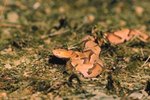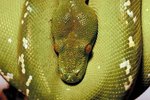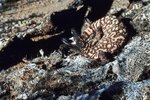
Approximately 27 snake species, representing five different families, are native to Haiti. While Haiti is one of the few places in the world with no snakes that are dangerously venomous to humans, 11 species of the family Dipsadidae use venom to subdue small prey.
Family Typhlopidae
Haiti is home to several species of blind snake (Typhlops sp.), though authorities differ on the exact number. CaribHerp, an educational resource maintained by Pennsylvania State University, lists 10 species native to Haiti. However, work done as early as 1964 by Niel D. Richmond of the Carnegie Museum lists several species not included in CaribHerp’s list. Blind snakes are primitive, burrowing serpents with reduced eyes. They subsist on invertebrates including worms, ants, termites and their larvae. The differences between the various species are subtle; only experts can easily identify the individual species. Blind snakes are dark brown to pink, and rarely exceed 12 inches in length.
Family Leptotyphlopidae
Thread snakes strongly resemble blind snakes. They are small, brown to pink snakes with reduced eyes; some researchers call them slender blind snakes. Despite this similarity, scientists classify thread snakes in their own family, the Leptotyphlopidae. Two species live in Haiti: Thomas’ slender blind snake (Mytophis pyrites) and a close cousin, the La Selle threadsnake (M. leptepileptus). Both species are small, averaging about 8 inches in length.
Family Tropidophiidae
The dwarf or wood boas are a group of primitive, constricting snakes who live throughout the Caribbean Islands. Though called boas, these snakes form their own separate family from the boas, family Trophidophidae. Haiti is home to one species; the Haitian dwarf boa (Tropidophis haetianus). Haitian dwarf boas have a brown ground color with green spots; interestingly, their colors are lighter at night than during the day. These snakes reach a maximum size of about 18 inches but are usually much smaller. They primarily prey on lizards and frogs. When confronted by a predator, dwarf boas may roll into loose balls, emit musk, flee or bleed from the eyes, nose and mouth.
Family Boidae
Three members of the family Boidae live in Haiti; scientists classify all three of them in the same genus, Epicrates. Gracile boas (E. gracilis) have laterally compressed bodies, which help them to climb trees. Hispaniola desert boas (Epicrates fordii) are smaller than many other boas, reaching only 30 inches in total length. The Hispaniola boa (Epicrates striatus) shows great variation in color across the creature's range; one of the most beautiful forms is bright orange to red in color. All three species kill their rodent, bird and lizard prey by constriction.
Family Dipsadidae
Haiti is home to 11 snake species formerly in the family Colubridae reclassified into the family Dipsadidae. Scientists consider snakes in this family harmless, but they do possess small fangs and venom. Four racers of the genus Hypsirhynchus inhabit the region: Tiburon hog-nosed racers (H. scalaris), Hispaniolan lesser racers (H. parvifrons), Hispaniola olive racers (H. melanichnus), and the Hispaniola hog-nosed racer (H. ferox). Three other species, commonly called racers, represent the genus Ialtris: Tiburon banded racers (I. parishi), Hispaniola montane racerlets (I. haetianus) and W-headed racers (I. dorsalis). Three tree snakes chase lizards and frogs through the trees and vegetation of Haiti: greater sharp-nosed tree snakes (Uromacer oxyrhyncus), lesser sharp-nosed tree snakes (U. frenatus) and blunt-headed tree snakes (U. catesbyi). The Hispaniola brown racer (Haitiophis anomalus) is endemic to the island of Hispaniola.
References
- CaribHerp: Haiti
- Biodiversity Heritage Library: The Blind Snakes of Haiti (Typhlops) With Descriptions of Three New Species
- The Reptile Database: Tropidophis Haetianus
- Reptilia: Dwarf Boas of the Caribbean
- The Reptile Database: Mitophis Pyrites
- University of Texas, El Paso: Dipsadidae
- The Reptile Database: Hypsirhynchus Parvifrons
- MongaBay.com: Dominican Republic Sends Bulldozers to Destroy Wildlife Reserve, Home to Endangered Species
- Encyclopedia of Life: Epicrates Gracilis
- DominicanRedMountainBoa.com: Epicrates Striatus Striatus
Photo Credits
-
Joe Raedle/Getty Images News/Getty Images




